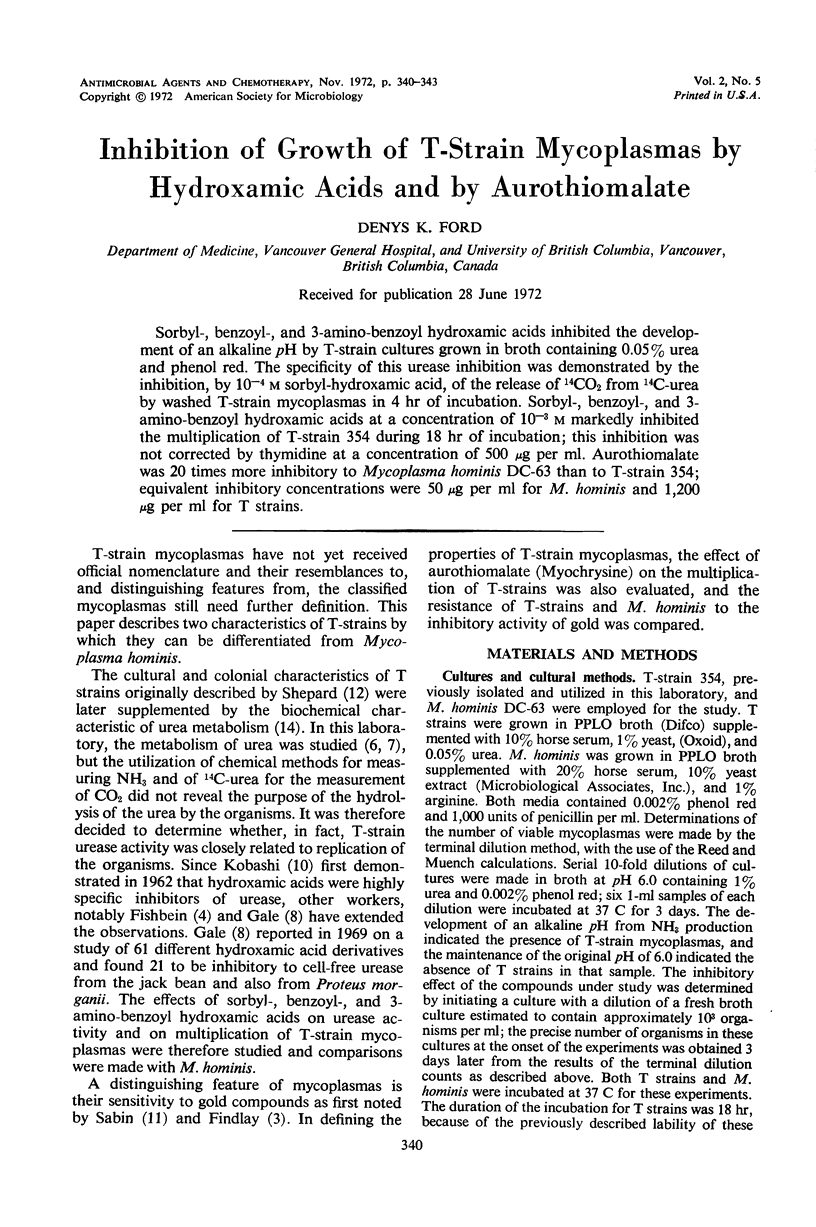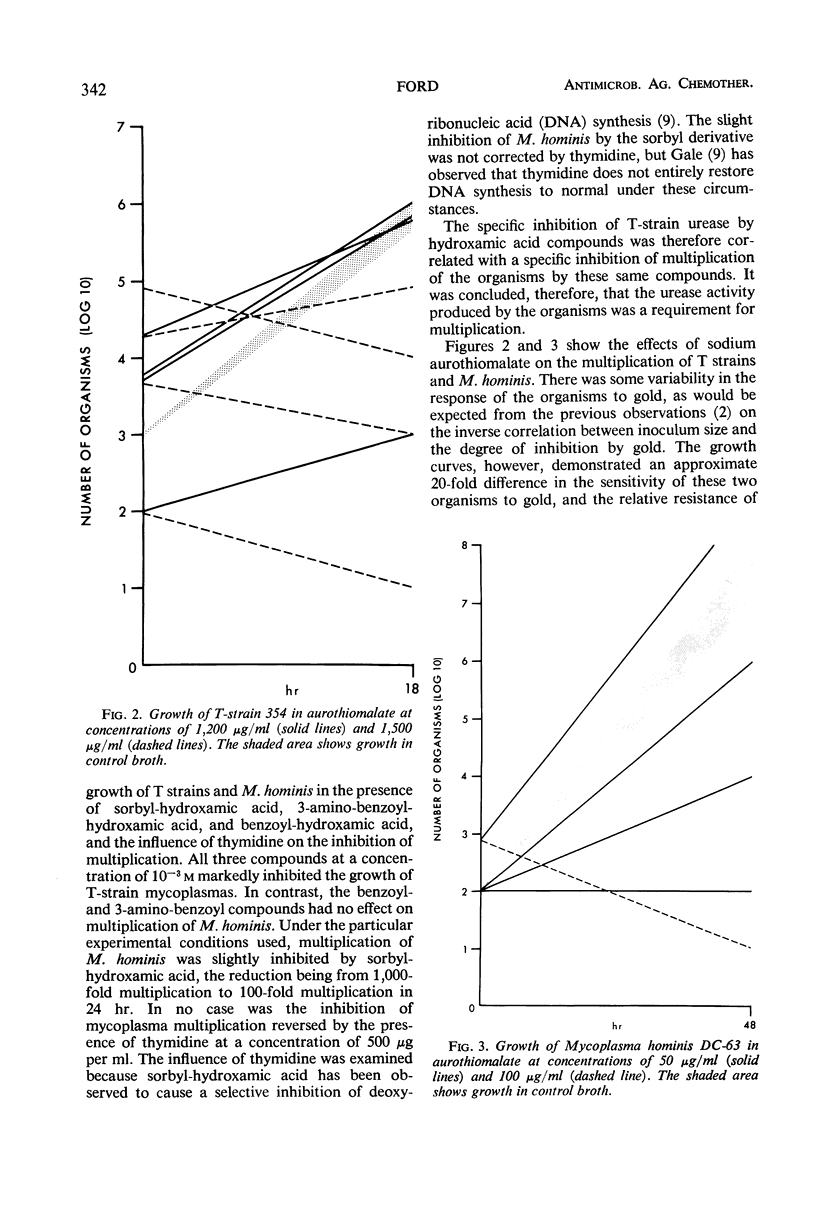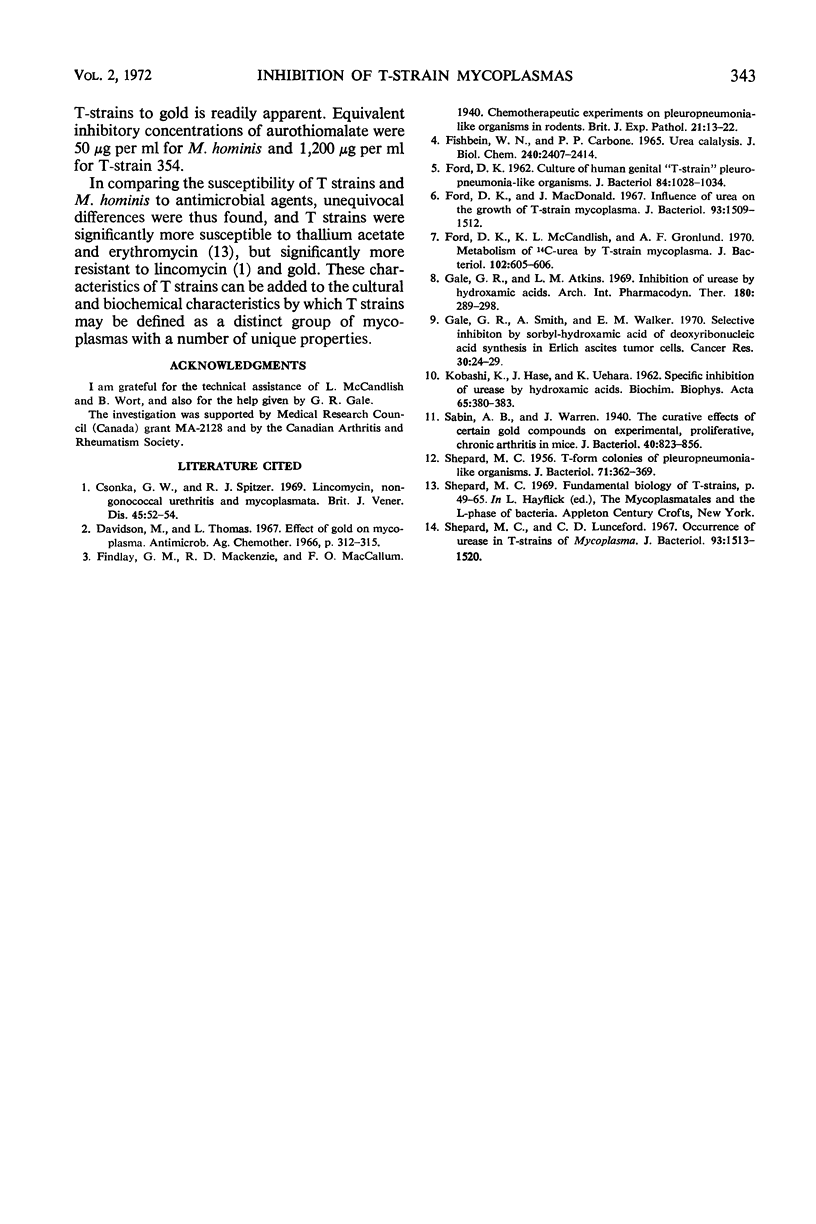Abstract
Sorbyl-, benzoyl-, and 3-amino-benzoyl hydroxamic acids inhibited the development of an alkaline pH by T-strain cultures grown in broth containing 0.05% urea and phenol red. The specificity of this urease inhibition was demonstrated by the inhibition, by 10−4m sorbyl-hydroxamic acid, of the release of 14CO2 from 14C-urea by washed T-strain mycoplasmas in 4 hr of incubation. Sorbyl-, benzoyl-, and 3-amino-benzoyl hydroxamic acids at a concentration of 10−3m markedly inhibited the multiplication of T-strain 354 during 18 hr of incubation; this inhibition was not corrected by thymidine at a concentration of 500 μg per ml. Aurothiomalate was 20 times more inhibitory to Mycoplasma hominis DC-63 than to T-strain 354; equivalent inhibitory concentrations were 50 μg per ml for M. hominis and 1,200 μg per ml for T strains.
Full text
PDF



Selected References
These references are in PubMed. This may not be the complete list of references from this article.
- Csonka G. W., Spitzer R. J. Lincomycin, non-gonococcal urethritis, and mycoplasmata. Br J Vener Dis. 1969 Mar;45(1):52–54. doi: 10.1136/sti.45.1.52. [DOI] [PMC free article] [PubMed] [Google Scholar]
- Davidson M., Thomas L. Effect of gold on Mycoplasma. Antimicrob Agents Chemother (Bethesda) 1966;6:312–315. [PubMed] [Google Scholar]
- FISHBEIN W. N., CARBONE P. P. UREASE CATALYSIS. II. INHIBITION OF THE ENZYME BY HYDROXYUREA, HYDROXYLAMINE, AND ACETOHYDROXAMIC ACID. J Biol Chem. 1965 Jun;240:2407–2414. [PubMed] [Google Scholar]
- Ford D. K. CULTURE OF HUMAN GENITAL "T-STRAIN" PLEUROPNEUMONIA-LIKE ORGANISMS. J Bacteriol. 1962 Nov;84(5):1028–1034. doi: 10.1128/jb.84.5.1028-1034.1962. [DOI] [PMC free article] [PubMed] [Google Scholar]
- Ford D. K., MacDonald J. Influence of urea on the growth of T-strain mycoplasmas. J Bacteriol. 1967 May;93(5):1509–1512. doi: 10.1128/jb.93.5.1509-1512.1967. [DOI] [PMC free article] [PubMed] [Google Scholar]
- Ford D. K., McCandlish K. L., Gronlund A. F. Metabolism of 14C-urea by T-strain mycoplasma. J Bacteriol. 1970 May;102(2):605–606. doi: 10.1128/jb.102.2.605-606.1970. [DOI] [PMC free article] [PubMed] [Google Scholar]
- Gale G. R., Atkins L. M. Inhibition of urease by hydroxamic acids. Arch Int Pharmacodyn Ther. 1969 Aug;180(2):289–298. [PubMed] [Google Scholar]
- Gale G. R., Smith A. B., Walker E. M., Jr Selective inhibition by sorbylhydroxamic acid of deoxyribonucleic acid synthesis in Ehrlich ascites tumor cells. Cancer Res. 1970 Jan;30(1):24–29. [PubMed] [Google Scholar]
- KOBASHI K., HASE J., UEHARA K. Specific inhibition of urease by hydroxamic acids. Biochim Biophys Acta. 1962 Dec 4;65:380–383. doi: 10.1016/0006-3002(62)91067-3. [DOI] [PubMed] [Google Scholar]
- SHEPARD M. C. T-Form colonies of pleuropneumonialike organisms. J Bacteriol. 1956 Mar;71(3):362–369. doi: 10.1128/jb.71.3.362-369.1956. [DOI] [PMC free article] [PubMed] [Google Scholar]
- Sabin A. B., Warren J. The Curative Effect of Certain Gold Compounds on Experimental Proliferative, Chronic Arthritis in Mice. J Bacteriol. 1940 Dec;40(6):823–856. doi: 10.1128/jb.40.6.823-856.1940. [DOI] [PMC free article] [PubMed] [Google Scholar]
- Shepard M. C., Lunceford C. D. Occurrence of urease in T strains of Mycoplasma. J Bacteriol. 1967 May;93(5):1513–1520. doi: 10.1128/jb.93.5.1513-1520.1967. [DOI] [PMC free article] [PubMed] [Google Scholar]


